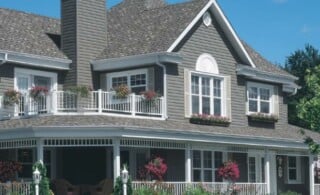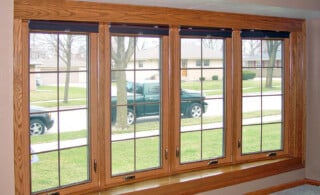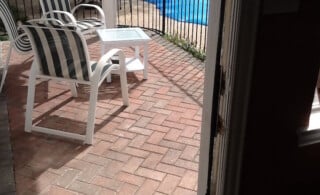

Left/Top: Photo: Diane / Adobe Stock
Bottom/Right: Photo: pics721 / Adobe Stock
On This Page:
- What Is a Double-Hung Window?
- What Is a Single-Hung Window?
- Appearance
- Cost
- Upkeep
- Durability
- Installation
- Life Span
- Environmental Impact
- Versatility and Customization
- Are Single- or Double-Hung Windows Better?
- Single- and Double-Hung Windows vs. Other Options
Single- and double-hung windows are known for their classic appearance and may look similar at a glance. Still, both offer significant differences in cost, versatility, energy efficiency, and maintenance. The major difference between single- and double-hung windows is the number of sashes. On single-hung windows, the top sash is rigid while the bottom sash can move up and down. Whereas on double-hung windows, both sashes can move up and down.
What Is a Double-Hung Window?
A double-hung window has two stacked, movable sashes (the part of the window that holds the pane). This allows the window to slide down from the top and up from the bottom, meaning both sashes can open simultaneously. Most models have the capability for both the top and bottom sashes to tilt in and out, offering versatility.
What Is a Single-Hung Sash Window?
A single-hung window has one fixed sash on the top and one movable sash on the bottom. This allows the bottom sash to slide up, partially covering the top sash. They typically cannot tilt in and out.
Appearance
Single- and double-hung windows don’t look very different from afar. The main difference is how they function. Both windows are available in many colors, styles, and materials, including aluminum, wood, vinyl, and fiberglass.
| Single Hung | Double Hung |
|---|---|
| Come in many colors, styles, and materials | Come in many colors, styles, and materials |
| Look more authentic in historic homes | Becoming more popular for modern homes |
Single Hung
Single-hung windows were the norm before double-hung became available, so they look more authentic in updated historic homes. However, they can be used and look great in all types of homes, including more modern designs.
Double Hung
Both single- and double-hung windows come in various colors, styles, and materials, but double-hung windows typically have more options in this department. They are also more common in more modern homes rather than historic ones.
Cost
In general, single-hung windows cost less than double-hung windows. This is true for both new installation and replacement windows. Window installation costs will vary by how many you plan to install, their size, your existing frame structure, and the quality of the replacement unit.
| Single Hung | Double Hung |
|---|---|
| $150 – $400 per window | $400 – $650 per window |
| Less expensive frame materials | More expensive frame materials |
| Less expensive to install | More expensive to install |
Single Hung
The cost to install a window is typically between $250 and $6.700 per window. Still, single-hung windows are on the less expensive side, running $100 to $400 per window, as they require fewer movable parts. Because the fixed sash undergoes less wear and tear, you do not have to spend top dollar for optimal frame materials.
Double Hung
Double-hung windows are more expensive at $150 to $650 per window because they come in a wider variety of styles and framing options and have more movable parts. They require the highest-quality frame structure to keep the seal of the top sash from breaking down over time due to gravity’s pull, which can contribute to their higher expense.
Upkeep
Double-hung windows are easier to maintain in general, but both types of windows have their pros and cons when it comes to upkeep. For example, if you plan to have many second- or third-story windows in your home, you may want to consider how difficult it will be to clean the windows on higher floors and opt for double-hung windows. If your home is one story, it might not matter as much.
| Single Hung | Double Hung |
|---|---|
| Fewer movable parts, more long-term stability | More movable parts, potentially less long-term stability |
| More difficult to clean | Easy to clean |
Single Hung
Single-hung windows have fewer movable parts, meaning they typically remain stable for longer. However, there are a few disadvantages to upkeep with these windows. Cleaning is more difficult because you must do so from the outside.
They can’t tilt in like double-hung windows, so you’ll have to go outdoors to wipe them off, which can be particularly cumbersome and dangerous for homes with multiple stories. Spending a little extra to hire a local window cleaning service is safest for cleaning upper-level windows.
Double Hung
Double-hung windows are very easy to clean. They not only raise and lower to expose tough-to-reach spots but can also tilt inward, making them the simplest type to clean from indoors. This is an especially useful function for upper-level windows. However, the movable parts mean more opportunities for breakdown and the possibility of more maintenance costs.
Find a Local Window InstallerDurability
Single-hung windows are generally longer-lasting than double hung because of their lighter weight and fewer movable parts. However, double-hung windows are generally safer. Both types work well with vinyl, aluminum, or wood frames, though double hung requires the highest quality of these framing materials to ensure proper mobility and a seal over time. Weigh the pros and cons of each to decide which type of window will be more durable for your house.
| Single Hung | Double Hung |
|---|---|
| Fewer movable parts and lighter weight mean less wear and tear over time | More movable parts and heavier weight mean more wear and tear over time |
| Because these only open from the bottom, the risk of danger for small children or pets on upper levels is higher | The ability to open from the top while keeping the bottom closed decreases the risk |
| Fewer movable parts make them more weather-resistant | These have two locks (one for each sash) and a stronger, heavier frame (increasing safety) |
Single Hung
The fewer movable parts of the fixed sash increase resistance to harsh weather, water leakage, and air infiltration as the frame undergoes less use. But single-hung windows are more difficult to clean, and not cleaning them regularly could shorten the lifespan of the window over time. When dealing with a broken frame, it’s best to call in a pro. Even if only one sash breaks, expect to replace both at the same time
Double Hung
Both single-hung and double-hung windows are durable and long-lasting in general, but double-hung are easier to maintain. Since regular maintenance is a major factor in a window’s lifespan, being able to clean it properly can make it last longer. However, double-hung windows also require more upkeep to maintain a secure latch as gravity pulls down on the upper sash, and the increased mobility means more wear and tear on the frame and seals.
Installation
The cost of replacing your windows can pay off in energy savings and the increase in the value of your home. It requires accuracy and expertise to fit windows properly, so hiring a quality pro is key for installation.
| Single Hung | Double Hung |
|---|---|
| Installation is less expensive | Installation is more expensive |
| DIY installation is simpler | Complex installation (not a good DIY project) |
Single Hung
Single-hung windows are generally easier and faster to install, as it is simpler to fit in the pieces with fewer moving parts. Professional window installers typically charge between $45 and $60 per hour, so a single-hung window installation costs less than a more time-consuming double-hung window installation. DIY installation is a simpler project for these windows as they have lighter frames and arrive as fixed units.
Double Hung
Double-hung windows are more complex to install, as installation requires precision measurements to fit these windows with more movable parts and ensure a proper seal and mobility. It’s not a good idea to replace these yourself as they are heavier, and the complexity of the moving parts means more opportunities for costly mistakes.
Life Span

Photo: Nick Beer / Adobe Stock
In general, double-hung windows last anywhere from eight to 30 years, while single-hung windows typically last anywhere from 15 to 30 years. However, multiple factors impact that number. The average life span for all types of residential windows is 20 years.
| Single Hung | Double Hung |
|---|---|
| Lighter with a longer lasting frame and seals | Heavier, which could decrease the lifetime of the window frame and seals |
| Lasts 15 – 30 years on average | Lasts 8 – 30 years on average |
Single Hung
Single-hung windows tend to last longer and need fewer replacement parts than double hung, primarily due to their lighter weight and fewer removable parts. Keeping your windows clean and regularly inspecting them for issues will help increase their lifespan and keep them secure.
Double Hung
Because double-hung windows are heavier, the window frame and seals may not last as long as those on lighter single-hung windows. However, a window’s lifespan depends on how well-maintained they are over time.
Environmental Impact
Choosing double-paned windows and prioritizing U Factor ratings for both styles will increase energy efficiency. But both types of windows are environmentally friendly in different ways. For example, double-hung windows can help achieve optimal open airflow and reduce the need for air conditioning in a hot climate. Single-hung windows have a better seal to keep in heat and reduce cold drafts if you live in a cold climate.
| Single Hung | Double Hung |
|---|---|
| Offers both an airtight seal on the top and ventilation on the bottom | Movable parts increase the possibility of a poor seal |
| Limited ventilation | Maximum ventilation |
| Lower energy costs over time | Potential for higher energy costs over time |
Single Hung
Limited ventilation means you may still have to spend more on cooling your home over time, depending on your climate. However, the tighter seal (due to the immovable top) is better at keeping in heat during the colder months.
Double Hung
If installed properly, the maximum natural ventilation could save energy while cooling your home over time. However, the moving parts increase the possibility of a poor seal if the frame materials aren’t the highest quality or maintained properly. This could factor into air infiltration and higher energy costs, especially in the colder months.
Ready to Start Your Window Installation?Versatility and Customization
Overall, both types of windows offer versatile options in terms of appearance and style. However, in terms of versatility of movement, double-hung windows beat out single hung. Selecting the best type of window will depend on your home.
| Single Hung | Double Hung |
|---|---|
| Variety of materials, trim, and colors | Variety of materials, trim, and colors |
| Fixed (immovable) sash | Operable (movable) sashes do not allow for custom sizes or shapes |
| Can hold multiple panes of glass per sash (2 over 2, 6 over 6, etc.) | Can hold multiple panes of glass per sash |
Single Hung
Single-hung windows have an immovable sash that can be any size or shape, like a picture window. They can be more easily customized for homes with unique sizes or shapes and hold multiple glass panes per sash.
Double Hung
Double-hung windows come in a wider variety of materials, trim, and colors than single hung to better match the look of your overall home design. The main difference between these two types of windows is that double-hung windows have movable sashes, so they can open from the top or the bottom. This is appealing to many homeowners but can also be a disadvantage because they can’t come in custom sizes or shapes. Like single-hung, double-hung windows can also hold multiple panes of glass per sash.
Are Single-Hung or Double-Hung Windows Better for Your Home?
If you’re looking for the most budget-friendly option, single hung is likely the best choice for you. However, if you want windows that will be long-lasting, easy to maintain, and come in various styles to match the rest of your house, double hung might be the better option.
Be sure to speak with a window installation specialist near you who is knowledgeable about which styles and materials hold up best in your climate before making a decision. See how these two types of iconic windows compare as you evaluate the best window style for your home.
| Single Hung | Double Hung | |
|---|---|---|
| Appearance | Provides a more authentic look in historic homes | More styles and materials are available |
| Cost | $150 – $400 per window | $400 – $600 per window |
| Upkeep | More difficult to clean | Easier to clean |
| Durability | Resistance to air and water infiltration | Provide better ventilation for rooms with lots of moisture |
| Installation | Easier and more affordable to install | More expensive and more complex to install |
| Lifespan | Have fewer movable parts, increasing their long-term stability | Heavier, meaning they can wear out more quickly over time |
| Environmental Impact | Energy efficient with an airtight fixed sash | Energy efficient with maximum airflow capability, saving you money in long-term cooling costs |
| Versatility | One movable sash | More versatile, with two movable sashes |
For Homes With Kids or Pets
Double-hung windows tend to be safer for children and pets because the bottom portion of the window can stay closed while the top portion—which they can’t reach—can stay open to let air in. This is especially true for homes with an upper story where the window provides access to dangerous heights.
For Two- or Three-Story Homes
Double-hung windows are generally better for two- or three-story homes primarily for safety reasons. They also are much easier to clean. You don’t necessarily have to clean double-hung windows from the outside like you would with single-hung windows. This means no climbing up on a ladder or struggling to reach the window to clean it.
Single-Hung and Double-Hung Windows vs. Other Options
Single-hung and double-hung windows aren’t the only types you can choose from. Other popular window styles to choose from include casement and sliding windows. Casement windows, also called crank windows, allow maximum ventilation and are ideal for hard-to-reach spaces or egress windows. However, they take up a lot of space when they’re open, so that’s something to plan for in your home’s design.
Sliding windows are easy to clean and a good option for openings that are wider than they are high. However, their flexible seal is less energy efficient than other window types.
Need a Window Installation Professional? Thermal Replacement Windows – Questions & Answers
Thermal Replacement Windows – Questions & Answers  Low-e Windows – Are They Worth the Investment?
Low-e Windows – Are They Worth the Investment?  U-Factor & Thermal Replacement Windows
U-Factor & Thermal Replacement Windows  Smart Glass: A Solar Light Switch
Smart Glass: A Solar Light Switch  The Benefits of Weather Stripping
The Benefits of Weather Stripping 

Are You Familiar With This Topic? Share Your Experience.